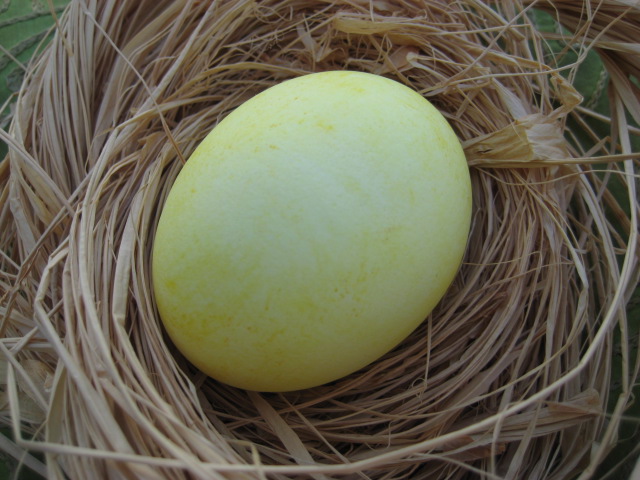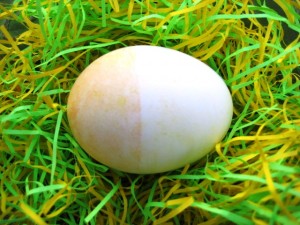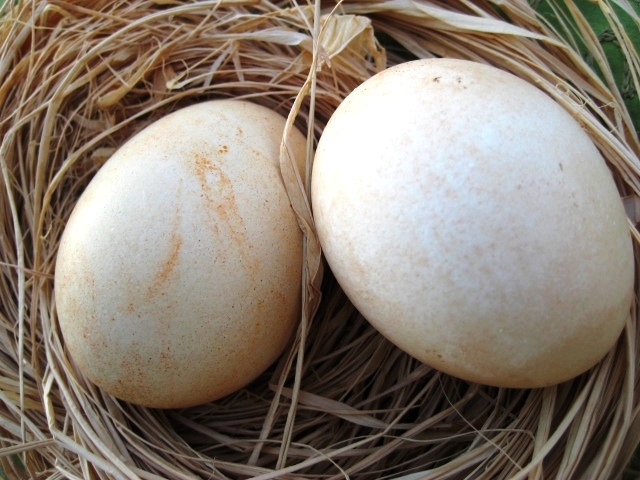You don’t have to go far on the web to find recipes on how to make natural food coloring. I’m simply taking it one step further. Instead of the usual beets and onion skins let’s open the spice cupboard.
Making homemade Easter egg dye with spices intrigued me for several reasons:
- Convenient ingredients.
- Easy process.
- Promise of pretty eggs.
- That warm, fuzzy feeling that comes with eating local, going organic and being au natural.
Don’t get me wrong, we love the perky, chirpy colors that come with the usual Paas coloring kit but we see these colors every year. We want to add to the palate. Yes, there are glitter eggs, marbled eggs, tie-dye eggs: blah, blah, blah; too complicated and messy for our tastes. We want the tidy little bathtub of color, a white oval canvas, and coloring gratification.
So do spices as a natural food coloring work? In a word, yes. But that yes is a matter of perspective. Here are the homemade Easter egg dye recipes and results. It’s up to you to decide if it’s worth your effort.
How to Make Natural Food Coloring
1. Paprika for orange.
- 2 tablespoons ground paprika.
- 2 cups of water.
- 1 tablespoon vinegar.
Boil the paprika and water for 5 minutes. Add the vinegar. Wait until the water cools.
Results:
This was interesting. At first I let the egg sit in the paprika coloring for 20 minutes creating some interesting swirls but more of orange-brown. 
When the egg was simply dunked and dried it resulted in a brighter, perkier orange. 
3. Turmeric for yellow.
-
2 tablespoons ground turmeric.
-
2 cups water.
-
1 tablespoon vinegar.
Boil the turmeric and water for 5 minutes. Add the vinegar. Wait until the water cools.
Results:
Wow, now we’re talking egg color! Knew turmeric would come through. After, all it did wonders for the naturally colored candy corn cookies I made at Halloween. This time, not only did my kitchen smell flowery (how does a root smell like a flower?) but it rendered a happy, sunshine-y yellow. 
I got creative and plunked my half-paprika egg in the turmeric to see what would happen:
 Not bad. The yellow would be sharper if I had the patience to hold it for at least 5 minutes.
Not bad. The yellow would be sharper if I had the patience to hold it for at least 5 minutes.
4. Cinnamon for brown.
-
2 tablespoons ground cinnamon.
-
2 cups water.
-
1 tablespoon vinegar.
Boil the cinnamon and water for 5 minutes. Add the vinegar. Wait until the water cools.
Results:
I decided to try brown mostly to see if it differed that much from the turmuric. What do you think?
Yeah, I agree. Actually the paprika egg looked brighter when nestled next to the turmuric. But overall I wasn’t that thrilled with the cinnamon. Reminded me of a regular brown egg.
4. Parsley for Green?
Save your efforts. I tried the recipes above but substituted dried parsley for the spices. Hardly detectable. Perhaps the secret is getting the chlorophyll with fresh parsley. Tried that. Just pale, yellow water.
There are other ways to get richer colors but you need to enlist the beets and blueberries. These weren’t spices so they weren’t on the to-try list.
 Final words?
Final words?
I can’t help but say this with a twinge of severe guilt. I’ll continue to experiment with spices and other natural colorings in the Easters to come. However, good ‘ol Paas Easter kits will always have a place in our home. Springtime wishes everyone!





April 10, 2012 at 2:49 pm
spinach will give you a good green colour, but even better is nettles! I love this idea…the turmeric one is my fave. 🙂 Theresa
April 10, 2012 at 8:33 pm
I’m still hesitant to work with nettles! Really, all you have to do is dunk them in warm water and they won’t sting?
April 15, 2012 at 8:49 pm
Thank you for the great post! I can think of no prettier way to decorate eggs than with natural coloring. I am going to save this for next year. Allen.